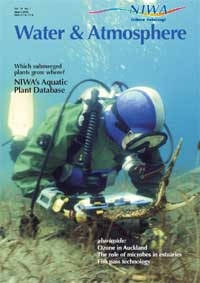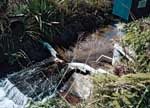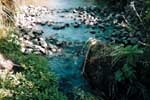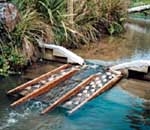PDF of this article (2 MB)

Eddie Bowman David Rowe
An innovative fish-pass design allows small native fish to safely undertake their upstream migration yet does not interfere with hydrological measurements.
Many dams, culverts and weirs are barriers to upstream migration of native fish. Designing ways to allow fish to pass such obstacles is a significant area of research. However, weirs installed for flow measurement present special problems because adding devices to assist fish passage can make the weir less accurate for measuring stream discharge.
In 1995 Fletcher Challenge Forests Ltd commissioned NIWA to monitor the effects of logging on stream ecosystems within the Taneatua Forest, Eastern Bay of Plenty. Hydrological monitoring in the Wainui Stream required construction of a weir, so a resource consent was obtained for the predicted 10-year duration of the project.
The resource consent included conditions to ensure that the passage of indigenous fish through the weir was not blocked. A NIWA study carried out before the weir was built found that smelt and inanga, which are not particularly strong swimmers, were present above the weir site. The consent therefore required construction of a fish ramp below the weir to ensure these species could move past it, and periodic monitoring to ensure that these indicator species were present above the weir as well as below it.

View of fish pass before remedial work.

The riffle–pool sequence through the riprap.

The first addition of the tanalised half-rounds. (Protruding timber has been cut off since this photo was taken.)

Upstream view showing path of fish through riprap and into fish pass.
Fish-pass problems
During construction of the weir, a wooden fish pass was built on the downstream side. This comprised a ramp measuring approximately 1.2 m wide and 2.0 m long, inclined at an angle of approximately 5°. Small blocks (50 mm x 40 mm x 10 mm high) were also fixed to the ramp to help break up the flow and create rest points for migrating fish.
Initially, this pass seemed to work: fish thought to be inanga or smelt were seen above the weir between 1996 and 1998. However, during that period several large floods partially scoured out the stream bed directly below the weir. As a result, from time to time, the ramp was higher than the water level in the pool below the weir. Water spilling into the pool created an insurmountable barrier for small native fish.
During routine visits, rocks were moved around below the ramp to help maintain the water level above the bottom edge of the ramp. But in 1999, a large flood scoured out the streambed leaving a free fall of approximately 100 mm between the ramp and the pool (top photo). A fisheries survey carried out after this flood confirmed that the fish pass was no longer working. Action was needed to provide a more permanent solution.
The solution
Table 1. Spot velocities recorded in the three flow sections of the fish pass
| Approx distance from top (m) | Water velocities (m/s) | ||
|---|---|---|---|
| Right | Middle | Left | |
|
0.1 |
0.22 |
0.61 |
0.16 |
|
0.8 |
0.31 |
0.94 |
0.48 |
|
1.2 |
0.07 |
1.01 |
0.38 |
|
1.4 |
0.34 |
1.22 |
0.35 |
|
1.8 |
0.13 |
1.01 |
0.11 |
Since the original fish pass was built in 1995, much new information has been produced on indigenous fish passes (see Further reading). In addition, experimental work at NIWA has looked at the ability of inanga to surmount weirs of different shapes and vertical drops and at different flows (see Whitebait can’t jump). Therefore it has been possible to incorporate some new ideas and findings into the new design.
First the stream bed was stabilised downstream of the weir using rip-rap, a layer of large rocks (150–225 mm wide) laid so that each boulder locks against its neighbour (second photo). Rocks of this size will shift only under very high water velocities (>3.3 m/s). They were carried from the road to the site by helicopter in one-tonne bags and then arranged to provide a pool–riffle sequence.
It is highly unlikely that the water velocities in the Wainui Stream will exceed 2.0 m/s, so this rip-rap should maintain water levels below the weir, preventing any fall from developing.
The ramp was also upgraded. Baffles were added to break the flow into three separate channels. Tanalised half-rounds of various sizes were added randomly to the two outside channels of the ramp to mimic natural cobbles found in the faster sections of the stream (third photo). The middle section had no added artificial substrates and thus had stream flows two to three times faster than those through the two outside sections. The higher flow through the middle section (see Table 1) helps to guide fish to the two slower sections on each side (bottom photo).
Most fish passes fail because the fish cannot follow the flow to the entrance of the fish pass or because the flows exceed the swimming ability of fish. Our design therefore both guided fish to the edge of the ramp and provided lower flows up the outer channels, which allowed them to make the ascent.
Success and lessons
Teachers: this article can be used for Technology L7 A.O. 6 (a). See other curriculum connections at www.niwa.co.nz/pubs/wa/resources
Shortly after the fish pass was changed, large numbers of small fish were seen above the weir. An electric-fishing survey confirmed that they were inanga and that the fish pass was working. Inanga, common and blue-gilled bullies – all non-climbing and poor-swimming species – are now present above the weir.
In addition, the design provides a potentially useful tool to further refine the construction of fish ramps over weirs.
For example, low water velocities are essential at the entrance and exit points of fish passes. In the new fish pass, the half-round obstructions in the outer channels were positioned so that they would slow down water velocities to less than about 0.3 m/s. Table 1 shows that slower velocities were definitely achieved, but were sometimes greater than 0.35 m/s in the outer channels. Also, velocities in the left channel were generally higher than in the right-hand one. Therefore, fish may not be using the left channel. Even if confined to the right one, they may not use the entire channel width. The routes taken by fish as they swim up the ramp are unknown. Their detection (for example, by video camera) would allow measurement of the water velocities and depths used by fish. Such data could then be used to improve the spacing and placement patterns for obstructions in both this and other, larger ramps.
Our new design is expected to provide fish passage for native fish without impeding water flow and affecting hydrological measurements. It is also expected to survive future flood events. It shows that “fish-friendly” hydro-logical weirs can be constructed and that low-tech solutions to fish passage are possible.
Eddie Bowman is based at NIWA in Rotorua; David Rowe is at NIWA in Hamilton.
Further reading
Boubee, J.; Jowett, I.; Nichols, S.; Williams, E. (1999). Fish passage at culverts: A review, with possible solutions for New Zealand indigenous species. NIWA and Department of Conservation.
Mitchell, C. (1991). Fish pass designs which may have potential for New Zealand native freshwater fish. Freshwater Catch 47: 15–18.
Acknowledgements
We would like to thank Clive Tozer and Gavin Williamson of Fletcher Challenge Forest Ltd for their invaluable help during the upgrade of the Wainui Weir fish pass.
